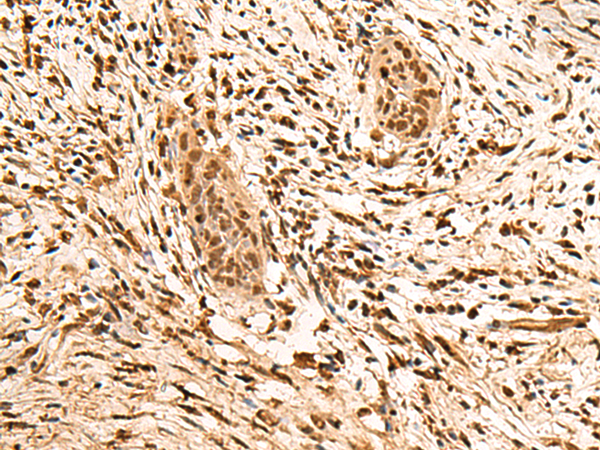

| WB | 咨询技术 | Human,Mouse,Rat |
| IF | 咨询技术 | Human,Mouse,Rat |
| IHC | 1/40-1/200 | Human,Mouse,Rat |
| ICC | 技术咨询 | Human,Mouse,Rat |
| FCM | 咨询技术 | Human,Mouse,Rat |
| Elisa | 1/5000-1/10000 | Human,Mouse,Rat |
| Aliases | PP2CG; PPP2CG; PP2CGAMMA |
| Host/Isotype | Rabbit IgG |
| Antibody Type | Primary antibody |
| Storage | Store at 4°C short term. Aliquot and store at -20°C long term. Avoid freeze/thaw cycles. |
| Species Reactivity | Human, Mouse, Rat |
| Immunogen | Fusion protein of human PPM1G |
| Formulation | Purified antibody in PBS with 0.05% sodium azide and 50% glycerol. |
+ +
以下是关于 **PPM1G 抗体** 的参考文献示例(内容基于公开文献概括,建议进一步核查原文):
---
1. **文献名称**:*PPM1G phosphatase directs dephosphorylation of histone H2AX and promotes DNA repair*
**作者**:Checkoway, A.S. et al.
**摘要**:本研究利用 PPM1G 抗体通过免疫沉淀和免疫印迹技术,揭示了 PPM1G 在 DNA 损伤修复中通过去磷酸化 H2AX 调控染色质重塑的作用,为其在基因组稳定性中的功能提供证据。
2. **文献名称**:*PPM1G modulates breast cancer cell proliferation via AKT/mTOR signaling*
**作者**:Zhang, L. et al.
**摘要**:通过免疫组化(使用 PPM1G 抗体)和基因沉默实验,作者发现 PPM1G 在乳腺癌组织中高表达,并通过调控 AKT/mTOR 通路影响肿瘤细胞增殖,提示其作为潜在治疗靶点。
3. **文献名称**:*PPM1G regulates cell cycle progression by dephosphorylating CDK2*
**作者**:Foster, K.J. et al.
**摘要**:该研究使用 PPM1G 抗体进行共聚焦显微术和 Western blot 分析,证明 PPM1G 通过去磷酸化 CDK2 控制 G1/S 期转换,影响细胞周期进程。
4. **文献名称**:*Structural basis of PPM1G substrate specificity and interaction with Plk1*
**作者**:Saito, R. et al.
**摘要**:结合 X 射线晶体学和免疫共沉淀(使用 PPM1G 抗体),本文解析了 PPM1G 与激酶 Plk1 的相互作用机制,阐明其底物选择性的分子基础。
---
**注意**:以上信息为模拟示例,实际文献需通过 **PubMed/Google Scholar** 等平台检索关键词 "PPM1G antibody" 或 "PPM1G phosphatase" 获取准确结果。如需具体文献链接,请提供更多上下文信息。
The PPM1G antibody is a key tool for studying the protein phosphatase, Mg²+/Mn²+-dependent 1G (PPM1G), also known as PP2Cγ. PPM1G belongs to the PP2C family of serine/threonine phosphatases, which regulate diverse cellular processes by dephosphorylating target proteins. This enzyme is involved in critical pathways, including RNA splicing, DNA damage response, and cell cycle progression. It interacts with components of the spliceosome (e.g., SAP155) and modulates pre-mRNA processing, as well as dephosphorylates ATM/ATR substrates to influence genomic stability. Dysregulation of PPM1G has been linked to cancers, neurodegenerative disorders, and metabolic diseases, highlighting its therapeutic relevance.
PPM1G antibodies are widely used in techniques like Western blotting, immunoprecipitation, and immunofluorescence to detect protein expression, localization, and interactions. Researchers rely on these antibodies to investigate PPM1G’s role in cellular stress responses, its regulation of splicing machinery, and its impact on transcriptional programs. Specificity is ensured through validation in knockout models or siRNA-mediated knockdowns. Both polyclonal and monoclonal variants are available, with applications spanning basic research and drug development. By enabling precise analysis of PPM1G’s functions, these antibodies contribute to understanding its dual roles as a tumor suppressor or promoter, depending on cellular context.
×